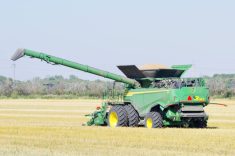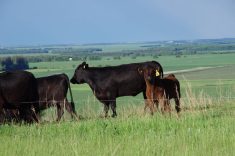To say Thanksgiving weekend was a wake-up call for those of us living in rural Manitoba would be an understatement.
The mid-October snowstorm that swept through the south-central zone between Brandon and Winnipeg is one for the memory books, ranking right up there with the Colorado low that shut down the region in March of 1966, the ice storm that wiped out power for days in March of 1986 and the early-April storm that set the stage for the 1997 Flood of the Century.
Read Also

Calling all farmers: What do you want us to ask at the Ag in Motion farm show?
Ag in Motion is back July 15-17, 2025; we want to know the production questions you need our reporters to ask
If people living through it were thankful for anything, it was that the temperatures were relatively mild. Had this happened in the dead of winter, living through the power outages that ranged from a few hours to still ongoing would have been about survival, rather than inconvenience.
However, the timing presented unusual challenges especially for farmers with crops still in the fields and livestock, either out on pasture or in confined housing. The mix of rain and snow combined with gale-force winds makes it almost impossible for animals to stay warm. Getting feed to them and making sure they didn’t get mired in the snow or muck was also a challenge.
The Manitoba harvest was only 75 per cent complete when that storm hit and a lot of the crops still out in the fields tend to be higher-value contributors to farmers’ bottom line.
The Oct. 15 provincial crop report captures the gravity: 40 per cent of the potatoes, 20 per cent of the canola, 70 per cent of the soybeans, 40 per cent of the dry beans and 90 per cent of the corn crops have yet to be harvested. It’s not clear when farmers will get back at it.
As it was, seeing the lights go out and hearing the house go silent late Friday afternoon became for us, a series of Simpson-like “doh’s” starting with — gosh, those weather forecasters were actually right this time.
In reality, they’ve been getting it right most of the time for a long time now, but many of us still cling to the old adage that you can always count on the weatherman — to get it wrong.
The generator we bought six years ago and had started up a couple of times to see if it runs was tucked in the back corner of a shed and needed to be transported across the yard through knee-deep snow. Thankfully, we had two jerry cans of fresh gas on hand, which seemed like more than ample — until the power was still out on Saturday morning and we realized it was unlikely the gas pumps in town would be working.
As darkness descended, I located four flashlights, three of which had dead batteries. Initially, we still had our phones and I was able to check in on elderly relatives. But by Saturday morning, all communication technology involving landlines, cellphones, and internet had failed community-wide.
Our only source of incoming information was a transistor radio (with dead batteries) or the radio in our vehicles. Our only way to communicate with the outside world was to drive someplace on highways that were closed and nearly impassable.
The municipal water supplies were compromised because of the power outage and hundreds of households in the area were without tap water or the ability to flush toilets. Downed trees and power lines made getting around hazardous.
By Saturday night, people were coming to the reception centre set up in one of the local halls with the help of a generator to find a hot cup of coffee, a sandwich — and some human contact. Entering a second night in the dark with no heat was psychologically difficult for many.
The scope of the challenge was enormous for Manitoba Hydro. At one point there were more than 260,000 reports of outages, thousands of broken power poles and hundreds of downed transmission towers.
There were also surprises and near misses in the aftermath of their herculean efforts to turn the lights back on across rural Manitoba. People who were cooking when the power went off didn’t always think to turn the stove off, nor did they remember it was on. There were some carbon monoxide scares too, linked to generators and alternative heating sources.
The Old Farmers’ Almanac is predicting it will be a snow-stormy winter. It might be right or it might be wrong. Who wants to gamble on the latter?
Spare gas? Check. Extra batteries? Check. Stored water? Check…




















